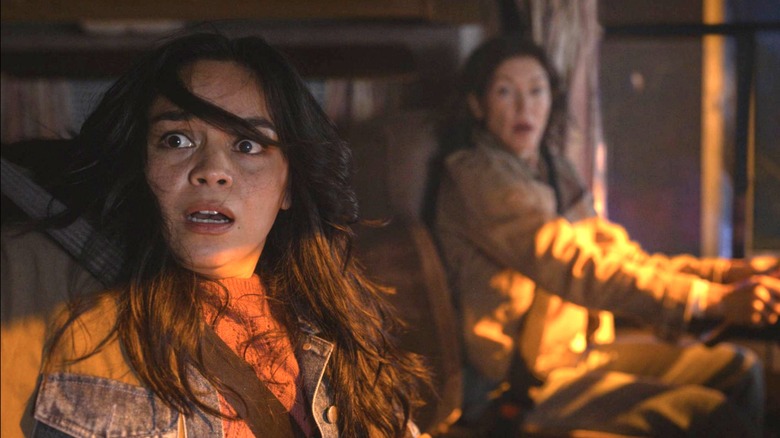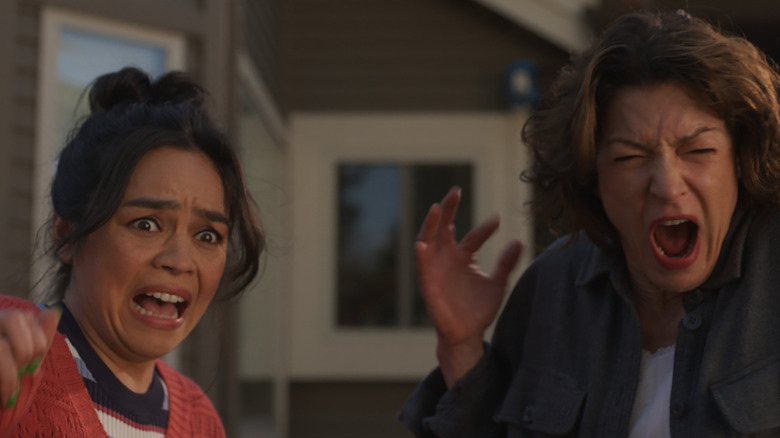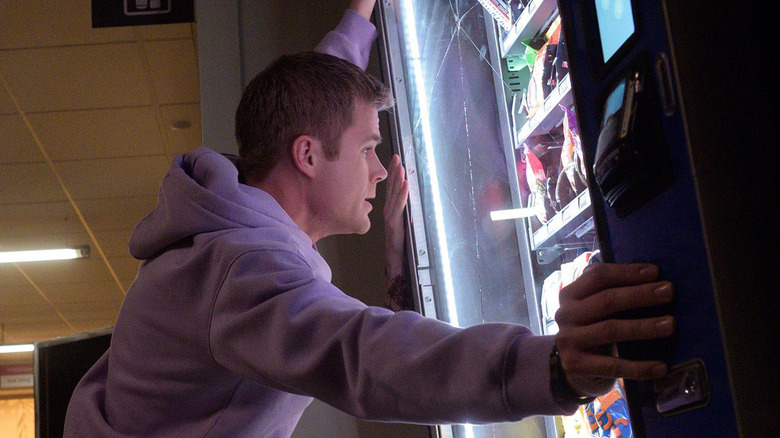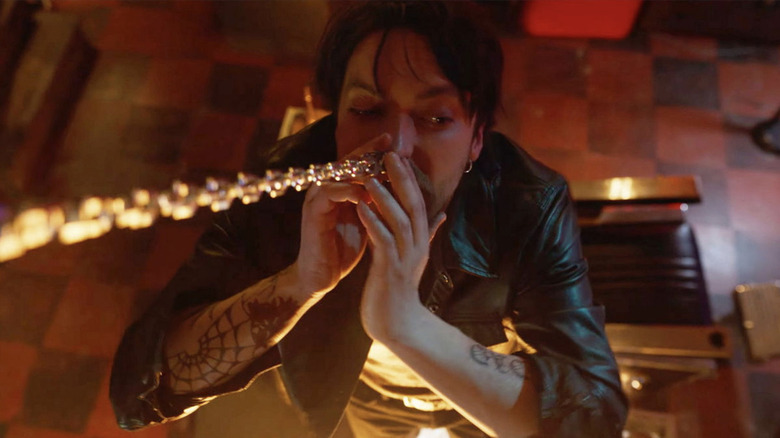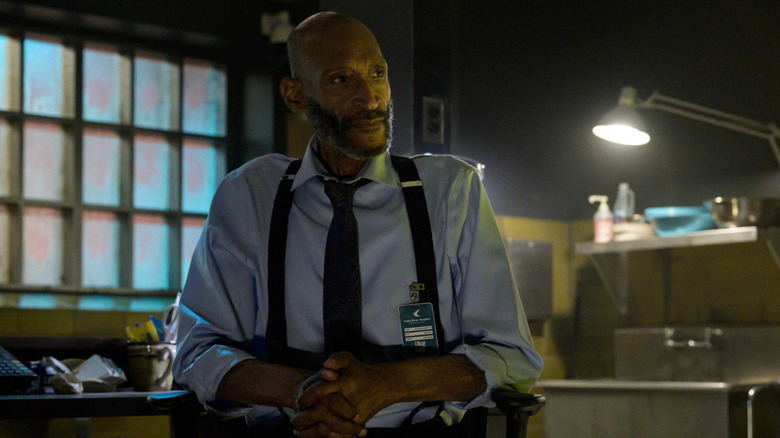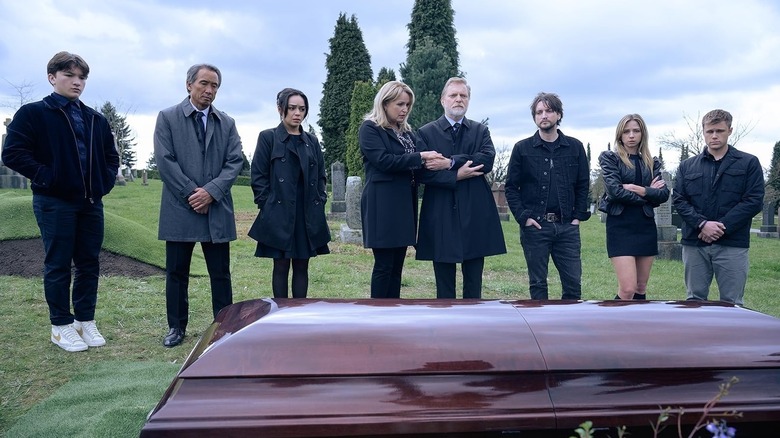Final Destination Bloodlines Directors Learned Valuable Horror Lessons From Disney [Exclusive Interview]
This article contains mild spoilers for "Final Destination Bloodlines."
After 14 long years of waiting, the beloved Rube Goldberg machine-inspired horror franchise has added some more tallies to Death's scoreboard with "Final Destination Bloodlines." The sixth entry in the series is arguably the best it's ever been, a bloody fun time from start to finish with an unexpected amount of heart. The movie works exceptionally well because everyone involved very clearly understands what it is that makes audiences return to the series time and again, including the marketing team, who have promotional logging trucks driving around Los Angeles. With a screenplay from Guy Busick and Lori Evans Taylor with Jon Watts of "Spider-Man: No Way Home" and "Skeleton Crew" fame boasting a "story by" credit, "Bloodlines" is directed by Adam Stein and Zach Lipovsky, who earned their jobs in the most "Final Destination" way possible.
"Bloodlines" had the seemingly impossible task of awakening a franchise in hibernation while also telling a story that made sense within the sprawling lore established in five previous movies, and somehow, these maniacs pulled it off. In honor of the film's theatrical release, I sat down with Lipovsky and Stein to talk about what goes into making a successful "Final Destination" movie, what they're now afraid of thanks to researching wild death scenarios, and why directing R-rated gorefests is not so different than working on a Disney Channel Original Movie.
Note: This interview has been lightly edited for clarity and brevity.
From Kim Possible to Final Destination
People love to dog on Disney Channel original movies, and yet there are so many horror icons who have worked in that space — Nick Castle, Dean Cundey, Duwayne Dunham — and you brought "Kim Possible" to life. What did you take from your experience working in the family-friendly space that you think is applicable in working on a rated-R gorefest?
Lipovsky: Yeah, I was actually also in a DCOM as a child. I was in "Zenon: Girl of the 21st Century," which, a lot of people –
Listen, I wasn't going to say it! [laughs]
Lipovsky: A lot of people love that movie! We took a lot from that experience. We love just the feeling of adventure, and we did a lot of that in that Disney space. We also — the way that we like to work kind of evolved through that process. When we were working with a lot of kids, we developed this process of getting what was written, but then also bringing improv into it, and making sure to try new things on set, because that's often what would bring kids' performances to life.
And as we've gone on to more of the more R-rated, gory craziness that we love, we've still brought that type of energy, of getting what we all wrote down but then giving the cast a chance to try new things in the moment. And a lot of that is in this "Final Destination" movie.
Stein: Yeah. The actors are all so incredibly talented. And even in the audition phase, we threw improv at them and said, "Now do the scene in your own words." And we were kind of looking for people who could be flexible like that. But there's improvisations from every character in this movie, that gave us brilliant new discoveries. Some of the biggest laughs in the movie are their off-the-cuff words that they said in the moment.
Bloodlines takes inspiration from Final Destination 3 in a key way
Something that I've loved about the "Final Destination" franchise are the characters that I can't wait to watch die. That doesn't exist in this movie, save for that one kid at the beginning. I love the core cast so much. Was that something that you consciously went into, wanting that?
Stein: Yes. But I'm curious, did that make the movie work less well for you? Were you yearning for those hate kills?
I feel like I got my catharsis with that kid getting exactly what he deserved. But it made me so much more invested in these characters, because it's a "Final Destination" movie: Everyone's going to die. I know that's how these work. And so, I feel instead of going like, "Oh yeah, I can't wait for this." It's, "Oh no. Oh no! I feel so bad for them!"
Stein: Yeah! So, that's one of the things that really got us excited about Jon Watts' story for this movie. Basing it all around a family and a family tree really gives it a lot more stakes and a lot more emotional depth to the characters. Because our previous movie, "Freaks," was also about a family. We love the stakes of that, and the layers of that in a genre setting, because it really makes you care and lean in more.
One of the inspirations was "Final Destination 3." And that relationship between Mary Elizabeth Winstead and Amanda Crew being sisters in that movie, I always felt like I cared much more when it came down to them. And it felt like, "Wow, if we can do a whole movie of that, and really feel the urgency?" It's not just someone dies, and the stranger turns to the other group of strangers and says, "Okay, who's next?" It's, "Oh my God, we're grief-stricken, but we can't even be in our grief because we have to urgently protect each other." So that was a really amazing opportunity.
And also, exploring the depth of a family — having grudges that you don't talk about, having secrets that the family has never revealed to each other, having family members who are distant — and then in the process of avoiding death, they all become closer. It was a really interesting structure, that a fractured family can come together while also running from death. So that was a really interesting way to kind of sink our teeth into the story.
The directors figured out Death's Design
I think it also adds something really new, because a lot of the "Final Destination" movies are either strictly about teenagers or early twentysomethings. And in the cases where we do have a parental figure, we don't spend a lot of time with them. And now we have these parents who have married into this, and they're just going to watch their whole family get massacred and there's really nothing they can do about it. It's just so heartbreaking. I really think that you did something very special here. It's not very often that a horror franchise gives its best entry in "6." That just doesn't happen.
Lipovsky: Everyone knows the sixth one's always the best one! [laughs]
It's always that way [laughs].
Stein: I mean, that's so awesome to hear. And we love all the feelings. We love the terror, and the laughs, and also the emotional stuff that you're talking about that really breaks your heart. Going to the theater is such a big deal for people these days, so we love the idea of trying to give them the experience where they feel everything in those two hours.
The flip side of that, these kills, they are so good. They are so, so good. And they are just meticulously designed! Half the fun of "Final Destination" is trying to figure out, "Oh, I know what's going to happen." It's why the gymnastics kill in "Final Destination 5" is so good, because you are so convinced of where it's going. Then it's like, "Just kidding! We're origami folding a person." So, what is the process like of trying to track these out, not just on the page, but also, how do you make that make sense for the viewer?
Lipovsky: It takes many years, and it's an incredible iterative process. We work with the writers, and there are these big round tables, where you're brainstorming, "What are the things that we can ruin for people? What are the very everyday experiences that we can just completely dement, so that anytime you see that in the rest of your life, you think of 'Final Destination?'" But then, physically, how do those things work? What else is in that space?
Then you write that down, and then it doesn't work, and then you make it a little bit better, and you go to the space and it doesn't work, and you get other new ideas. And that just iterates over many years. Another big part of it is trying to make it not predictable. That's really tricky to do, because as soon as you show the audience one thing, you have to still make sure that there's another way that it's all going to come together.
The balance beam scene that you were talking about, in "FD 5," was a key inspiration for the barbecue, because we loved how there's this tiny little object that's creating so much tension, that the whole audience is focusing on, but it also can't just be that someone swallows that piece of glass. It has to come in another way. And so, that was really inspired by the balance beam.
Another one that inspired us hugely was the spaghetti death from "FD 2." There's this spaghetti that gets thrown out a window. What an a-hole, that he does that, right? But then, all these other things happen. You forget about the spaghetti. And then, it comes back to kind of kill him in a way that he deserves. And that played into another big set piece that we have later in the movie. So a big part of it was just breaking down all the set pieces that have come before. What worked about them, what didn't? What are the moments –
Stein: Zach created a major spreadsheet with details of every kill.
Lipovsky: Yeah. And then, taking all those lessons into what we wanted to do here.
Final Destination Bloodlines is a warning to us all
I love hearing that, because the lore of all of it is one of the things that fascinates me the most. I was so thankful that after the screening, I saw [producer] Craig Perry, and he had Iris' book on him, and he was like, "BJ, do you want to look at the book?" I was like, "That's not a real question. Of course I want to look at the book." And even going through that book, and seeing how meticulous everything is, how it's all connected ... I wish that they would sell copies of that, because it would become an instant prized possession.
Stein: Well, there's the book, and also the Wall of Obituaries. We stuffed this movie full of as many Easter eggs as we could think of. But then, we also asked the crew to put even more in, without even telling us. And so, we're still discovering some things in the movie, even though we've seen it over a hundred times.
See, that's going to be me. I'm going to be that psycho once this hits physical media or streaming and I can actually go frame by frame. It's going to look like Pepe Silvia from "It's Always Sunny." It's going to be a nightmare for my house. But in thinking about, "What are you going to ruin for people?" I'm a pancreatic cancer survivor. I get a lot of MRIs, so thanks for that new fear. Terrible, terrible, nightmare thing for me. But where does that come from? How do you decide what's going to be ruined?
Lipovsky: Yeah. It has to be something that is very relatable, and it has to be something that could also be physically possible. It's very hard to find the things that overlap in that space, but it's very delightful when you find them. And then, you kind of think about, how can we make it as horrible as humanly possible, so that anytime anyone experiences that again, they think of our movie?
In the case of MRIs, that scene, always from the beginning, was basically the best part of the movie. And there was a lot of debates that we had about, "This scene is so good. Should we put it in the movie? Because it's going to make a lot of people not want to go to their MRI appointments." But the scene was just too good not to do, so we kind of had to put it in there.
I already had a lot of panicky feelings about my MRIs, because I have piercings. And so, I always would take them out, and they're like, "We're not going anywhere near your face. You're fine." And now, I can at least be like, "Did you see 'Final Destination Bloodlines?' I am taking them out!"
Stein: That's right.
Lipovsky: It's a health safety announcement, is really what it is.
Relatable scares get bigger reactions
Yes, exactly! Take your piercings out before you go and get your MRI [laughs]! I think my fascination with "Final Destination" is also that I was very fascinated growing up with that show, "1000 Ways to Die." And I think that there's a little bit of kindred spirit going on between all of those things. So I'm curious: Are there any weird, improbable fears that you have given yourself, either while working on this movie or doing research for it?
Stein: I can't wear my wedding ring anymore. I've switched to a silicone band, because when I wear my real wedding ring, I get freaked out now. And there was one time I was out to dinner with my wife, and my fingers started to swell up and I started to panic, and now I wear a silicone band.
I only wear mine for fancy occasions or if I'm on camera, because I also have a similar fear. You have a little bit too much salt in your body, and then suddenly your ring's on a little too tight. It's terrifying. And then I watched this movie, and I was like, "All right. At least that fear is now rooted in something. It's not just something I've made up in my head."
Lipovsky: And there's a term for it, being de-gloved.
I love a de-gloving scene. I think that they are one of the quickest ways to make people panic. I think it's the same reason why people freak out when they watch "Jackass" and they're like, "The paper cuts are worse than jumping off a building."
Stein: That was one of the biggest surprises about making this movie! The small things get a much bigger audience reaction than the big things.
I think it's because we at least know somewhat what that would feel like. Like, the septum piercing thing — I have a pulled piercing on my ear from a little cousin grabbing an earring and pulling it out, so I know what that feels like. So, when I watched the trailer, I was like, "Yeah, no wonder every septum-pierced kid on TikTok's flipping their rings up." I mean, the giant set pieces, that's what we have fun with, but it's the little ones that remind you, "No, we're like a half step away from this being real."
Stein: I'll give you an example: In the opening, there's this section where dozens of people are sliding down this enormous set, and clinging up against these windows that are 400 feet in the air, but the biggest reaction is the cutaway to an ankle breaking. And it's like, "All these people are going to die, and you all are screaming about an ankle breaking?!"
You might need therapy after Final Destination Bloodlines
I really do think it's because that's the relatable one. When people started falling, I have to admit, my first thought in my head is, I was like, "Oh, this is watching the propeller scene in 'Titanic' as a child." And, "Okay, I don't know what that feels like," but I know what it feels like to roll your ankle a little bit too hard. It's an awful feeling. So, my last question for you is, are you going to be paying for my therapy bills moving forward?
Stein: Warner Brothers, I think, yeah.
Cool. Cool.
Stein: Alameda Avenue.
Okay, fantastic. I will be sending all of my checks that way, because new things to be afraid of. Logging trucks weren't enough. You had to give me more.
Lipovsky: That's right.
Stein: Thank you so much. This was amazing.
"Final Destination Bloodlines" is now playing in theaters everywhere.
